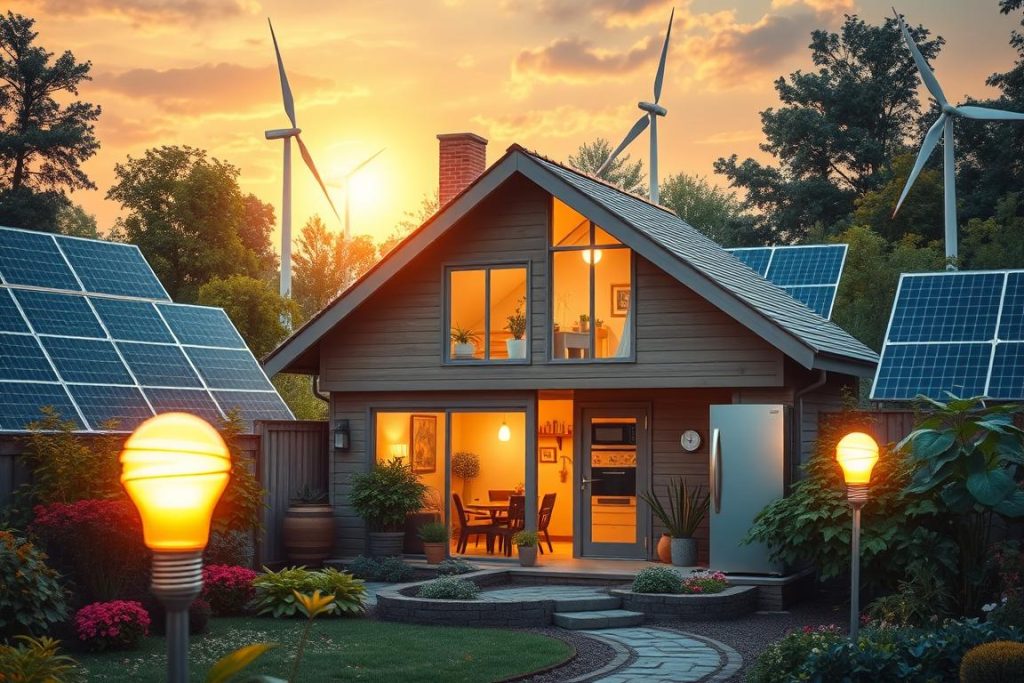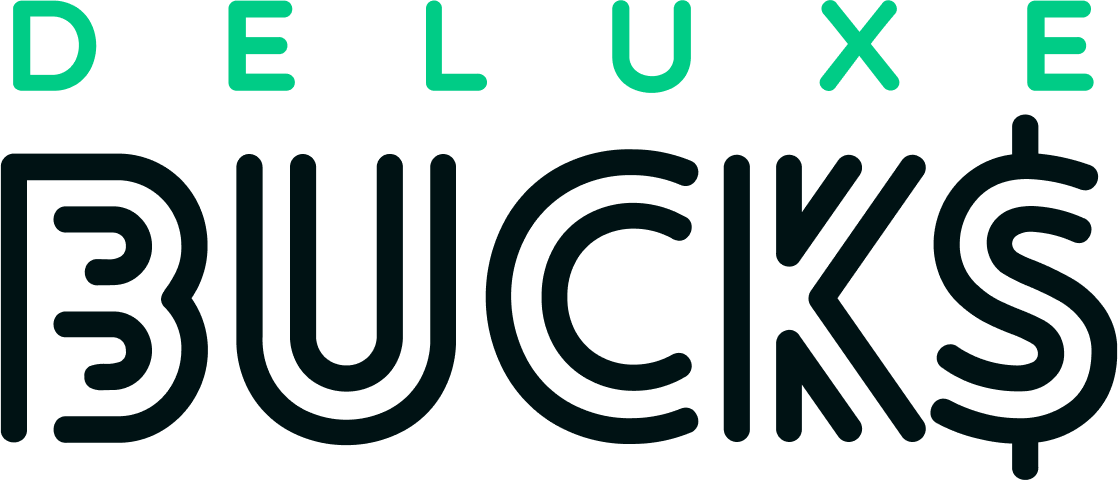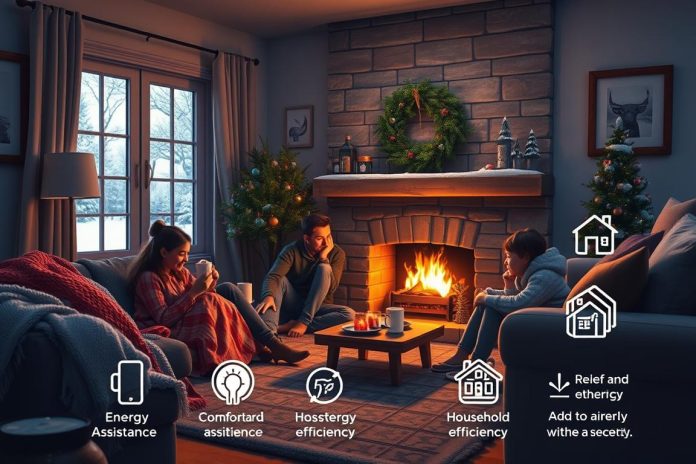When fall turns cold, heating your home can get costly. For low-income families, the winter brings extra worry about high energy bills. Many in America face a tough choice: stay warm or meet other basic needs. But, there’s good news for New Jersey residents: the Low-Income Home Energy Assistance Program (LIHEAP). This heating assistance program helps ease the burden of energy costs. It ensures no one has to suffer in a cold home.
LIHEAP offers many services. It helps with heating bills, cooling costs, emergency heating services, and making homes more energy-efficient. This is for households within certain income limits1. If you’re about to lose your power, these U.S. funded grants provide the help needed to keep things running2.
Starting your journey to warmer winters is easy. Just learn about the aid available and apply for heating assistance. These grants give hope that those in need can find support through New Jersey’s community programs.
Key Takeaways:
- Discover how LIHEAP provides much-needed low-income energy assistance during the expense-heavy winter months.
- Navigate the eligibility criteria to receive heating financial aid that lightens the burden of your energy bills.
- Understand the impact Federal and State programs can have on your household through direct financial support or energy-saving measures.
- Learn the steps to complete your heating assistance application for timely aid.
- Gain insight into how additional state-specific programs and resources can offer a wider safety net for those in need.
Understanding LIHEAP: A Lifeline for Low-Income Families
As winter comes, the Low-Income Home Energy Assistance Program (LIHEAP) helps many families. This program makes heating and cooling homes cheaper for them. If high utility bills are a problem, LIHEAP might be what you need.
What is LIHEAP and How Can It Help?
LIHEAP offers aid to those who need it most, like the working poor and the elderly. It helps avoid the tough choice between staying warm and buying food or medicine. Last year, it helped about 6.7 million homes, showing its big impact3.
Some families spend a lot on their energy bills each month. LIHEAP helps lower these costs. It makes sure families don’t suffer through extreme heat or cold3.
Eligibility Criteria for LIHEAP Assistance
The rules for getting LIHEAP help depend on your income, how many people live with you, and where you live. For example, a single person’s monthly income can’t be over $2,882.83. LIHEAP is there for those who really need it, based on state and federal guidelines3.
You’ll need to show proof of where you live, how much money you make, and your utility bills when you apply4. This makes sure the aid goes to the right people quickly.
Types of Aid Offered: Paying Bills and Emergency Support
LIHEAP help varies. It offers one-time payments for your heating and cooling bills and emergency aid when you’re at risk of losing service. The program’s budget grew a lot to better meet people’s needs3.
If you’re in an urgent situation, LIHEAP can provide fast help to solve your energy problems4.
Application Process: Steps to Access Heating Financial Aid
To apply, first reach out to the LIHEAP office in your area. Each place has its own way of doing things. The kind of help and how you apply varies, depending on where you live3.
Some places let you apply online, and others want you to apply in person. But no matter where you are, the aim is the same: to help you get LIHEAP aid easily and quickly.
LIHEAP is more than just financial help. It keeps your home warm in winter and cool in summer. This makes sure your family stays comfortable all year long.
The Heating Assistance Program and Additional Support Options
Energy costs keep going up. Thankfully, federal and state programs are here to help those who need it most. They offer heating grants and assistance for low-income families, which helps cut down on energy bills.
The Impact of Federal and State Heating Grants on Energy Costs
The Low-Income Home Energy Assistance Program (LIHEAP) helps families afford their energy bills. Next year, there’s going to be $4.025 billion available for LIHEAP. This means more families can stay warm in winter and cool in summer without worrying about huge bills5. An extra $100 million from the Infrastructure Investment and Jobs Act also boosts LIHEAP’s ability to help5.
Weatherization Assistance Program: Long-Term Energy Efficiency

The Weatherization Assistance Program (WAP) is all about making homes more energy-efficient. It includes adding insulation, fixing up homes, and installing energy-saving features. In 2023, $502 million will be spent to help low-income families save money through weatherization5.
Local Utility Programs: Finding Help with Utility Bill Help in Your Community
Local utility companies offer their own help programs. Companies like National Grid and Intermountain Gas have discounts and emergency assistance for those struggling with bills. Talking to your local utilities might reveal lots of ways to get help, some with easy-to-meet criteria.
Other Low-Income Energy Assistance Resources
States like Massachusetts and Arizona have their own programs to help, too. The Good Neighbor Energy Fund and Home Energy Assistance Fund help with things like energy bills and appliance repairs. They add even more support for low-income families6.
Using these resources can really lower your energy costs. It’s important to know about federal help and local programs. Each one has its own rules, and what’s available varies by place. So, getting to know what help you can get locally is key to benefiting from these programs.
Conclusion
Dealing with high energy costs is tough. Knowing about help like the Low Income Home Energy Assistance Program is key. This program has helped about 6.7 million homes in the U.S., plenty in Michigan78. But only 20% of those eligible get aid7.
If your income is less than 150% of the Federal Poverty Level, or even more depending on where you live, you should apply now for aid7.
During winter, state programs and utility companies also offer help. In Michigan, there’s the Home Heating Credit and the Low Income Winter Protection Plan. These programs stop the elderly and those in emergencies from losing their heat8.
Florida, New York, and Virginia have their own programs. They each have different rules for LIHEAP. This means more people can get the help they need7.
Many people have a hard time affording their energy bills. Over half say it leads to unsafe temperatures at home9. As the need for help grows, it’s clear these programs are essential, not just helpful. To get aid, look into the heating assistance program through LIHEAP. Use all resources available to keep your home warm and safe.
FAQ
What is the Low-Income Home Energy Assistance Program (LIHEAP)?
How do I know if I’m eligible for LIHEAP assistance?
What types of aid does LIHEAP provide?
What are the steps to apply for heating financial aid through LIHEAP?
How do federal and state heating grants affect energy costs?
What improvements can I expect from the Weatherization Assistance Program (WAP)?
How can local utility programs help with my utility bills?
Are there other energy assistance resources available besides LIHEAP and WAP?
Source Links
- Board of Public Utilities | Customer – https://www.nj.gov/bpu/assistance/programs/
- New Jersey | The LIHEAP Clearinghouse – https://liheapch.acf.hhs.gov/profiles/NJ.htm
- Low-Income Home Energy Assistance Program – https://myhelpinghandsact.com/liheap/
- Indiana Low Income Home Energy Assistance Program Intake and Operations Program Manual 2022-2023 – https://www.in.gov/ihcda/files/Indiana-LIHEAP-Intake-and-Operations-Program-Manual-PY2023-version-1.0-no-cover.pdf
- LIHEAP Fact Sheet – https://www.acf.hhs.gov/ocs/fact-sheet/liheap-fact-sheet
- Florida Low-Income Home Energy Assistance Program – https://floridajobs.org/community-planning-and-development/community-services/low-income-home-energy-assistance-program
- A Guide to Low Income Home Energy Assistance Programs – NerdWallet – https://www.nerdwallet.com/article/finance/low-income-energy-assistance-program
- utility-customers – https://www.michigan.gov/mpsc/consumer/get-help/utility-customers
- Utilizing $4bn to Protect Vulnerable Households from Extreme Heat – https://fas.org/publication/liheap-extreme-heat/


